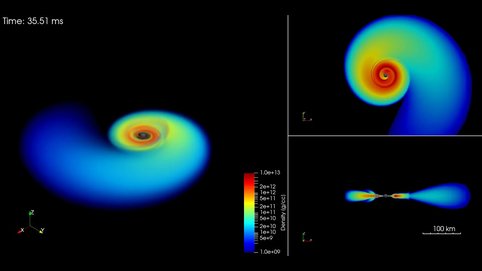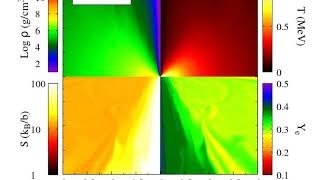Forschungsergebnisse und Animationen
2023
Numerical-relativistic simulation of a binary neutron star merger
The visualization shows the numerical-relativistic simulation of a binary neutron star merger. The simulation was done on the Japanese supercomputer “Fugaku” and used about 72 million CPU hours (corresponding to 8200 CPU years) with 20,736 CPUs. The neutron stars have masses of 1.2 and 1.5 solar masses, respectively, which is consistent with the parameters of the merger observed in August 2017 (GW170817). The data was generated during a one second-long general-relativistic neutrino-radiation magnetohydrodynamic simulation.
https://www.youtube.com/watch?v=I5pHQxYBSlA
The visualization shows the electron fraction on the left, the density in the center, and the magnetic field strength (1015 Gauss) on the right.
Second-long numerical-relativistic simulation of a binary neutron star merger
General-relativistic neutrino-radiation magnetohydrodynamic simulation of a one second-long binary neutron star merger. The simulation was done on the Japanese supercomputer “Fugaku” and used about 72 million CPU hours (corresponding to 8200 CPU years) with 20,736 CPUs. The neutron stars have masses of 1.2 and 1.5 solar masses, respectively, which is consistent with the parameters of the merger observed in August 2017 (GW170817).
https://www.youtube.com/watch?v=ZWXsA6e2BsI
The visualization shows profiles for rest-mass density (top-left), magnetic-field strength (top-second from left), magnetization parameter (top-second from right), unboundedness defined by the Bernoulli criterion (top-right), electron fraction (bottom-left), temperature (bottom-second from left), entropy per baryon (bottom-second from right), and Shakura-Sunyaev αM parameter (bottom-right).
Publication:
Self-consistent picture of the mass ejection from a one second-long binary neutron star merger leaving a short-lived remnant in general-relativistic neutrino-radiation magnetohydrodynamic simulation
E-print: https://arxiv.org/abs/2211.07637
2022
General-relativistic neutrino-radiation magnetohydrodynamic simulation of seconds-long black hole-neutron star mergers
Numerical simulation of a black hole-neutron star merger
The left side of the simulation shows the density profile (blue and green contours) with the magnetic-field lines (pink curves) penetrating the black hole, unbound matter (white color) and its velocity (green arrows). The right side displays the magnetic-field strength (magenta) and magnetic-field lines (light-blue curves).
https://www.youtube.com/watch?v=Tvk50Qnoor8
Publication:
General-relativistic neutrino-radiation magnetohydrodynamic simulation of seconds-long black hole-neutron star mergers
Physical Review D 106, 023008 (2022)
2021
Properties of the remnant disk and the dynamical ejecta produced in low-mass black hole-neutron star mergers
Merger of a low-mass black hole and neutron star leading to a black hole surrounded by an accretion disk
When a black hole (black sphere) and a neutron star (red sphere) merge, matter is ejected and forms an accretion disk surrounding the resulting black hole. The simulation shows the density of the ejected matter with colors ranging from blue (lower density), green, yellow to red (higher density).
https://www.youtube.com/watch?v=-pdNYuWWN_w
Publication:
Properties of the remnant disk and the dynamical ejecta produced in low-mass black hole-neutron star mergers
Physical Review D 103, 043007 (2021)
2020
Mass ejection from disks surrounding a low-mass black hole: Viscous neutrino-radiation hydrodynamics simulation in full general relativity
Viscous evolution of disks for Mdisk = 0.1 M⊙
Rest-mass density in units of g=cm3, temperature (kT) in units of MeV, specific entropy per baryon in units of k, and electron fraction Ye for model K8. The rest-mass density, the value of Ye, and the temperature of the atmosphere artificially added are ≈10 g=cm3, 0.5, and ≈0.036 MeV=k, respectively.
https://www.youtube.com/watch?v=GV_5DQIOv-E
Publication:
Mass ejection from disks surrounding a low-mass black hole: Viscous neutrino-radiation hydrodynamics simulation in full general relativity
Physical Review D 101, 083029 (2020)




